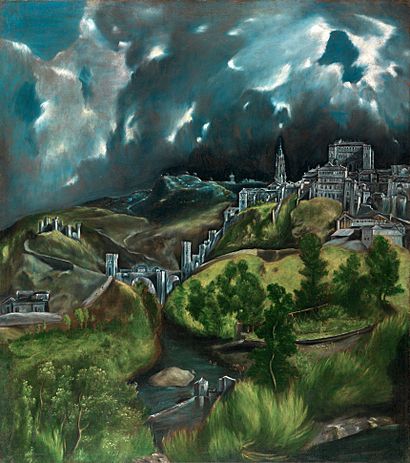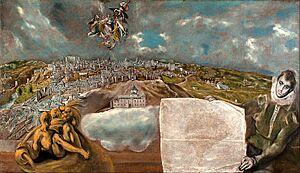View of Toledo facts for kids
Quick facts for kids View of Toledo |
|
|---|---|
| Spanish: Vista de Toledo | |
 |
|
| Artist | El Greco |
| Year | 1596–1600 |
| Medium | Oil on canvas |
| Movement | Mannerism |
| Dimensions | 121.3 cm × 108.6 cm (47.8 in × 42.8 in) |
| Location | Metropolitan Museum of Art, New York City |
View of Toledo (also known as Vista de Toledo) is a famous painting by the artist El Greco. It is one of only two landscape paintings he ever made. The other one is called View and Plan of Toledo. This amazing artwork is kept at the Metropolitan Museum of Art in New York City.
Many people think View of Toledo has one of the most striking skies in all of Western art. It is often compared to other famous sky paintings, like Vincent van Gogh's The Starry Night. Art experts, like Keith Christiansen, call it one of El Greco's greatest works.
Contents
About the Painting
When Was It Painted?
Art historians have talked a lot about the exact year View of Toledo was painted. Some early writings suggested it was painted after 1600. However, many experts now believe it was created between 1595 and 1600.
This idea comes from comparing it to another of El Greco's paintings, Saint Joseph and the Christ Child. That painting was finished around 1597-1599. Both paintings use similar techniques in their backgrounds. This suggests they were made around the same time.
Why Is This Landscape Special?
Landscape paintings were not very common in Spain during the Renaissance and Baroque periods. This makes View of Toledo quite rare and important.
Some people wonder if this painting was once part of a larger artwork. However, there is no real proof of this idea. It is thought that this painting might be the first Spanish landscape of its time. This is because a group called the Council of Trent had rules against painting landscapes.
What the Painting Looks Like
View of Toledo is a landscape picture. It uses strong colors like blues, blacks, whites, and bright greens. The colors are mostly earthy tones.
One of the most striking things is the huge difference between the dark sky and the bright green hills below. The painting shows a moody or dark feeling over the city of Toledo. The sky gets very dark right above the city.
El Greco used dramatic colors to create this look. You can see how light and dark colors are placed next to each other. Rolling hills are shown with the city of Toledo at the top. The city itself looks very grey compared to the bright green hills. Yet, the city also looks light against the very dark sky. El Greco used pure colors to make these strong contrasts.
The Castle of San Servando on the left side of the painting is shown in its correct spot. But many other famous places in Toledo are not in their real locations. Some art historians think El Greco painted Toledo this way to show how he imagined the city. He might have painted his ideal version of Toledo.
El Greco's Unique Style
El Greco had a very special way of painting. He was influenced by artists from Italy, Spain, and his home country, Greece. His style changed a bit depending on where he lived. However, his Greek roots always influenced his art.
He often wrote in Greek and used the Greek alphabet. You can see this tradition in View of Toledo because he signed his real name, Domenikos Theotokopoulos, in the lower-right corner.
El Greco's style was known for being a bit "uneven." You can see this in his lines and in how he placed Toledo's landmarks in the painting. He was part of the Mannerism art movement. But his use of color and shapes was truly unique.
Some experts believe that old Greek ideas and religious texts helped shape El Greco's style. They think his Greek background is clear in his later works.
View of Toledo vs. View and Plan of Toledo
El Greco painted two famous landscapes of the city of Toledo: View of Toledo and View and Plan of Toledo. The second painting is at the El Greco Museum in Toledo. Even though they show the same city, they look very different and send different messages.
View of Toledo was painted first. It feels more lively with its bright greens and whites against dark blues and blacks. View and Plan of Toledo has warmer, earthier colors, with lots of browns. It also shows the city from a higher, bird's-eye view.
These two paintings are quite different, even though they both show Toledo. It is believed that a man named Pedro Salazar de Mendoza asked El Greco to paint both of them. They were found in his art collection after he passed away. Salazar loved the city of Toledo very much. His passion for the city might have inspired El Greco to create both of these amazing paintings.

See also
 In Spanish: Vista de Toledo para niños
In Spanish: Vista de Toledo para niños

